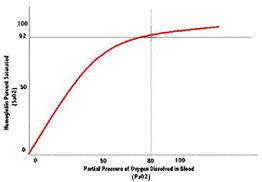- +1 800 433 4609
- |
- Request Info
Sp02
Sp02 can be broken down into the following components: 'S' indicates saturation; P indicates pulse, also SP can stands for serum pressure and 02 is oxygen. The abbreviation is a measure of the amount of oxygen affixed to hemoglobin cells within the circulatory system. In short, this reading indicates the amount of oxygen being carried by red blood cells. As a measurement, SPO2 indicates how effectively a patient is breathing and how well blood is being transported throughout the body. SPO2 uses a percentage to indicate this measurement. The average reading for a normal, fit adult is 96%.
What is it?
SPO2 is measure using a pulse oximeter, which consists of a computerized monitor and probe. The probe may be attached to a patientís finger toe, nostril or earlobe. The monitor then displays a reading of how saturated the patientís blood is with oxygen. It achieves this using a wave form which can be visually interpreted and an audible signal that corresponds to the patientís pulse. The tone of this signal decreases with decreases in blood saturation. The monitor also illustrates heart rate and an alarm is available to alert the user to fast/slow pulse rates and high/low saturation levels.
What does it do?
The SPO2 device measures both oxygenated and deoxygenated blood. Two different frequencies are used to measure these two different types of blood: red and infrared. This method is called spectrophotometry. The red frequency is used to measure desaturated hemoglobin while the infrared frequency is used to measure oxygenated blood. If the greatest absorbance is shown in the infrared band, this indicates high saturation. Conversely, if the greatest absorbance is in the red band, this indicates low saturation
How does it work?
Light is shone through the finger and the resultant rays are monitored by a receiver. Some of the light is absorbed by the tissues and blood and as the artery fills with blood, absorption increases. Similarly, as the arteries empty, the level of absorption decreases. Since the only variable in this exercise is the pulsating blood, the static components (i.e. skin and tissue) can be subtracted from the calculation. Therefore, using the two wavelengths of light collected during measurement, the pulse oximeter calculates the saturation of Oxyhemoglobin.

This chart depicts a PaO2 of 80 with 92% oxygen saturation in the hemoglobin. As the oxygen pressure increases, so too does the hemoglobin saturation levels. The hemoglobin reaches a maximum capacity at 105 or above. The PaO2 facilitates the indirect assessment of PaO2 through the measurement of Sp02.
97% Saturation = 97% PaO2 (normal)
90% Saturation = 60% PaO2 (danger)
80% Saturation = 45% PaO2 (severe hypoxia)
